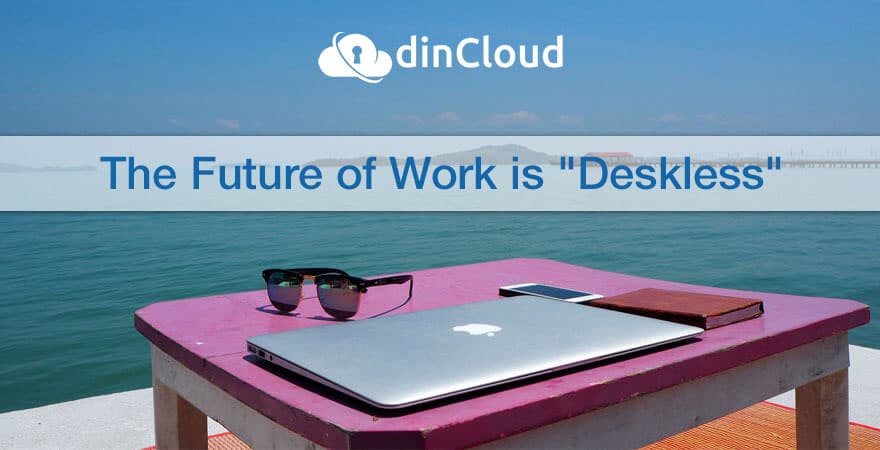Strategy Analytics Global Market Research report for 2017-2023 found that the number of employees working remotely will grow to 1.9 Billion by the year 2023, up from 1.5 Million in 2017.

How are advancements in technology increasing the productivity of businesses?
Advances in technology have increased the market for many businesses, turning it from a local market to a global market and increasing the amount of business travel that was required to effectively manage and maintain those vital business relationships. Hours and days away from this physical desk meant hours of lost productivity.
How Cloud Technologies are Enhancing Remote Work Strategies for Businesses?
Cloud technologies such as Desktop-as-a-Service (DaaS), Unified-Communications-as-a-Service (UCaaS) and others have helped businesses across the world enhance the mobility and productivity of their workforce and enabling the shift from a workplace environment based on a physical desk and only a physical desk. This move towards an entirely remote work strategy for businesses is not a new trend, but one that has been growing for years, meaning businesses are actively moving towards a “deskless workforce.”
The Freelancing in America survey found that by 2027, over 50% of the US Workforce will be freelance – and by default “remote,” leaving IT departments with the challenge of managing and securing corporate data without having the control over the network and physical device the worker uses to perform their job functions. Even for employees who are not freelance, the push towards enabling remote and flexible work options is significant.
LinkedIn Survey Finds “Deskless Work” is the “New Norm”
A survey performed by networking giant LinkedIn of over 5,000 LinkedIn members found a marked increase in the number of users indicating work flexibility as an important part of a job offer. The number of members talking about work flexibility jumped 78% from 2016 until now. Jason Phillips, the Vice President of Digital HR and Global Chief of Staff for the telecommunications company, Cisco, is quoted as saying, “Work flexibility is becoming the norm. The challenge is how fast can organizations provide it. Those that can are going to be in a far better position to retain top talent over the next three to five years.”
Flexible is the “New Normal”
The ability (or inability) of a company to provide flexible work environments is becoming one of the top factors in a candidates decision in accepting an offer or not, and it is not just a trend. The benefits of promoting this type of work environment go beyond just the employee but also the employer. Productivity was found to have increased by as much as 22% for a company in China when they instituted a flexible work environment to all 16,000 of their employees. The strategy also is saving businesses significant amounts of money when implemented. Companies like Dell saved $12 Million annually just by the ability to reduce the amount of rental space needed since they enabled their employees to work remotely or at variable hours. The benefits are endless, on both sides of the table.
Desktop-as-a-Service Facilitates a Deskless Workforce

While the advantages of a deskless workforce are significant, it may be overwhelming when trying to implement it, especially for IT. How is a business supposed to maintain the security of their data and equipment if they have no control over where and how it is used? But the solution is easier than you might imagine.
Technology, such as Desktop-as-a-Service, Communications-as-a-Service, and other “as-a-Service” offerings, have come a long way over the years and simplify the complexity behind enabling employees to work when, where and how they want while maintaining the security of corporate data.
Security is the #1 concern for businesses looking to implement a flexible strategy, but cloud solutions like dinCloud’s Desktop-as-a-Service (DaaS) solution ease the concerns. How? Look at these three key points:
- Remote Monitoring and Management – Remote monitoring and management turn cybersecurity assessments from reactive to proactive. The RMM solution includes alerting capabilities which warn of an issue before it reaches the business network and enables procedures to be put in place to stop any potential breach in its tracks.
- Multiple layers of security – To adequately secure a remote location hosting sensitive corporate data, multiple layers of both physical and digital security measures are essential. By combining these two efforts, businesses can significantly reduce the risk to businesses from a malicious attack.
- Cloud Service Providers are Experts on Security Protocols – Cloud providers have made it their business to keep up with the latest threats and techniques to combat malicious sources, meaning they have been given the best training and obtain the best talent in the industry in keeping business data secure.
Reap the Benefits of a Deskless Workforce with dinCloud
Surveys of businesses worldwide indicate that cloud technologies have made a significant difference in the productivity and profitability of their operation. The growth in the reliability of the technology, as well as the security standards in place that provide consistency in security protocols industry-wide, have removed many of the safety concerns of hosting data in cloud services. Bring in the future of work for your organization today with dinCloud’s industry-leading Desktop-as-a-Service offering.


